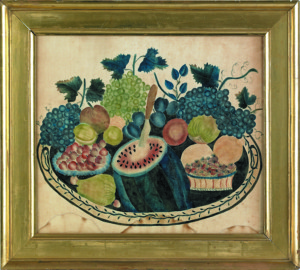Theorem paintings, that became popular in the early 19th century, began with the cutting of stencils into various shapes. Usually fruit and leaves were used, however rare examples have been discovered using bird shapes. A good example of what stenciled designs look like are antique Hitchcock chairs.
The first step was deciding what the main subject, such as a bowl of fruit, would be and the background material, usually velvet. The stencils were placed in various positions and filled in, with oil paints. 19th century theorem painters traced a design on transparent paper, cutting out the pattern and creating a stencil.
Stencil paintings old and new come to auction and prices can sometimes be competitive.
Antique theorems can turn up anywhere from barns to garage sales. In the 19th century theorem painting on velvet became a popular pastime for women around the country. It was a painstaking process as each stencil was placed on the velvet and held firmly in place with tacks or weights as each was painted with oil paints. The more skilled artists were able to create shading. These examples can sell for thousands of dollars. A good example is the large theorem, oil on velvet that sold for $10,665 at a Pook and Pook auction in 2012, depicting a platter of fruit. It was only estimated to fetch $2,500/3,500.
Theorems were also done on paper, cotton and silk. Some were made into pincushions and purses and given as gifts.
Often itinerant artists traveled town to town decorating floors, walls and wall screens with stenciled designs. Theorem painting went out of fashion by the 1840s.
During the 1970s, the 1976 Bicentennial stimulated interest in old theorems and a revival of the craft. While antique theorems weren’t always signed, contemporary examples were. There are still theorem artists working in the medium.
CLUES: Theorems on velvet don’t usually command as high a price as those on paper or wood. One of the problems can be condition, such as stains. Rarities, such as those done in Grisaille(shades of gray) get top dollar, since they were very difficult to do.
Theorems can sometimes be dated by the style of the glass container or basket holding the fruit and flowers. For example, pressed glass compotes, often used in theorems weren’t made before the 1830s.
One of the few known 19th century theorem artists who signed her works was Emma Jean Cady(1854-1933) of East Chatham, New York. Sometimes she added mica flakes to her theorems.
Be sure to check museums, such as the American Folk Art Museum, in New York City and the internet for information and photo images.
PHOTO CAPTION: (1) Theorem that sold for $10, 665 at auction.
PHOTO CREDIT: (1) Pook and Pook Auctions, 463 East Lancaster Ave., Dowinglon, PA, 19335
PHOTO CAPTION : (2) Grisaille(gray) theorem
PHOTO CREDIT (2) Peggy McClard Antiques, Houston, TX
















Follow Us